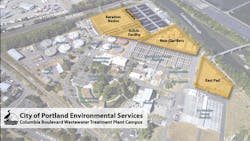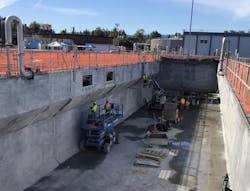The city of Portland’s Bureau of Environmental Services is constructing the largest set of upgrades to its main wastewater treatment plant in half a century, investing more than $400 million in projects towards resilience and efficiency.
The improvements will protect water quality, add seismic resilience to key portions of the plant, and replace equipment and buildings that have reached or exceeded their intended life span.
“Every Portland resident, business and visitor depends on the treatment plant operating continuously every day, throughout the year, and through all weather conditions,” said commissioner Mingus Mapps. “These upgrades will help continue reliable service that protects our environment, public health and worker safety.”
Environmental Services plans to complete the set of projects, collectively called the Secondary Treatment Expansion Program (STEP Program), by 2024.
Construction practices will focus on environmental stewardship, with more than 90 percent of construction waste slated for recycling, green roofs installed on new structures, energy-efficient structures and equipment used and other practices. In addition, Environmental Services is working with its contractors to encourage and cultivate a more diverse workforce in the construction trades.





